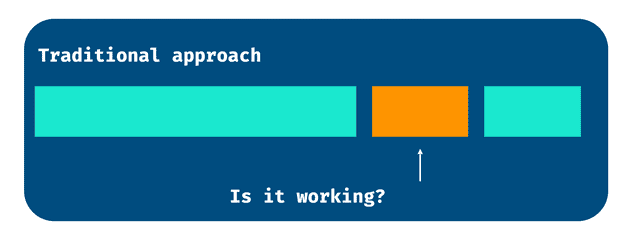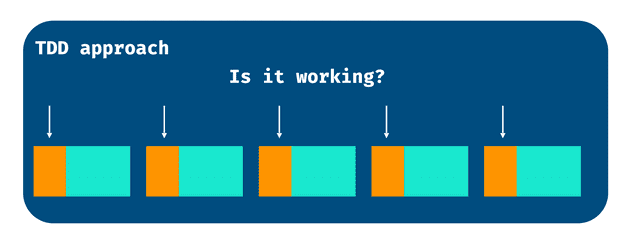What is TDD? TDD stands for Test-Driven Development and it is a Software Development’s process that was credited to Kent Beck. The idea consists of writing unit tests for your program, making them fail, then introducing the minimum amount of code that is enough to make the test pass, then you continue writing more tests according to your requirements at hand. By having tests in place, any change you do on your main code (let’s call it production code from now) can be checked against those tests and running them for every new change can be a way to get faster feedback, as an alternative to boot your application (whatever that is), run by each scenario and check if things are working as expected.
My journey
TDD (Test-Driven Development) is one of many techniques for developing software and this article aims to share my personal experience with it. I hope that I can clarify my thoughts on when I believe it can help and when I believe we should take a step back. I need to say that I found TDD pretty difficult and abstract at first. There will always be a space for discussion and that’s why other processes such as pair-programming and code review are extremely complementary to what I consider healthy software development processes. Let me give you some context before I start, so then you can understand better where I came from.
I’ve started reading about TDD on the internet and what helped me the most in my first steps were the articles from the Caelum website. I found really nice examples of how to do it at the time through their articles and further I found books which led me to the formal definitions written by Kent Beck. Then I joined ThoughtWorks in 2011 and there I believe it was a turning point for me. ThoughtWorks is famous for its revolutionary mindset (look for the agile manifesto), the Tech Radar publications and for caring about code quality. However, the reason I believe working there was so important was because of the people that I had a chance to work with at the time. They really encouraged me to challenge the current state of the code and how it could be improved. We also had a strong pair-programming culture which combined with writing tests, challenging code maintainability became pretty natural.
Why do I believe TDD is important?
Test-Driven Development enables refactoring.
As I mentioned above, having tests that exercise your code’s intention (function or method) opens room for refactoring the code with stronger confidence. You can move stuff around, you can rename things that express better what you are trying to do, you can add an argument to a function or you can remove them all. If after all of that you run your tests and they pass, chances are that you’ve done everything right! The opposite is true as well. If you change things and after running the tests some of them fail, it could be a sign that you’ve done something wrong and needs to be fixed. While refactoring the code, if you notice that one single change affects multiple tests, it could be a sign that the coupling between components is high or the scope of the change/refactor is big.
With time, I learned that TDD is not about testing first necessarily. The process of writing tests first, seeing them fail to then make them pass to be able to refactor really helps but the key factor to me was let the tests drive how I think so that my scope of changes can be expressed in the tests. I might want to refactor something, but if my scenarios are pretty small, I can postpone this decision for later.
Test-Driven Development favours design
TDD is all about letting your tests guide you about the problem you need to solve. It is pretty common to use the baby steps terminology here. Basically, you will start with really small and basic scenarios (for a given input, I expect this output). With that in mind, your code design should be simple enough to satisfy the requirements. Another aspect that can contribute to better design is that your test is the first consumer of your code. There you will call the function that you carefully named and thoroughly added certain arguments and you will see if that really expresses what you want to do. You may ask: “Should I really pass 4 arguments in here?” “Is this name good?” “Isn’t too complicated to set up the initial state for just testing if this does what it needs to do?” If the answer to this question doesn’t feel quite right, you can use this opportunity to change your code and look at your unit tests again and imagine: “how will someone call this code in real life? Is it easy to read?”.
Sometimes, “For a given input, I expect this output” is not possible. You could argue that it is not that simple as sometimes it is not easy to structure input and expected output. However, The fact that might not be possible all times doesn’t change the fact that you can always think about it and make it as an exercise. Challenge yourself often and see if this is really the case. If not, try breaking down your code into smaller components and then ask this question again.
Good code design is pretty subjective!
YES! That is it! If I’m coding all by myself I’m pretty sure I’ll understand it all and every decision will make sense until I have to explain to someone. That’s how pair programming and/or code review becomes crucial here. The process of doing TDD evolves empathy as well. I tend to think that we need to solve some problems right away, but often when I share my thoughts with someone I realise that I’m thinking too far ahead. Conversations like that can help you to avoid overengineering and make decisions prematurely. As we know by now, our tests are the first consumers of our code, so lean on that and discuss with your peers whether this is really a good design. Here are some questions that I often try to ask myself:
- Is my code easy to maintain?
- Is my code easy to change?
- Is my code easy to read?
- Is my code expressive enough?
TDD doesn’t mean bug-free code!
I’ve heard an argument before saying that if you’re doing TDD, your code shouldn’t have bugs. Well, I believe this is a bold statement. Of course, my code can have bugs. Test-Driven Development is a technique that requires discipline and experience. If I don’t follow the steps, for example, if I never see my tests failing, I can fall into the false positive trap. It is crucial to write a test, see it fail, then make it pass! The tests should also be reliable. Is part of the good design I mentioned above that our tests are also easy to read and maintain. They should be predictable and clean. If there are too many dependencies or setups, it could be a sign that my code is too coupled, therefore, it will be hard to maintain and false positives can be introduced. Besides, at this stage, you could argue if having tests is really adding value given the amount of setup that it might require if you come to that point.
There is another aspect to it, which is: we still can write tons of unit tests following all the rules, but with the wrong assumptions. If we don’t understand the problem we are trying to solve, we will end up having tests that will exercise something that doesn’t make sense with tests passing.
Tooling
In the previous sections, I’ve described techniques, beliefs and discipline. To make it stick and be pleasant, we need to have good tooling. The tests should be fast to run. It should be quicker to run a test than open the application (i.e. browser or mobile device) myself and test it out. While coding, it should be quick to trigger the tests as well. Nowadays, most programming languages’ ecosystems contain some tool where it watches your code and whenever you save a file, the tests relevant to that file will run. That is the sweet spot, in my opinion.
Final thoughts and when doing TDD doesn’t help
I believe that Test-Driven Development doesn’t help when we are not quite certain about what to do and what to expect. Sometimes, you might not be familiar with the language, framework or platform and you might need some time to play around with the available APIs and see what it is possible and what can be a constraint.
As the expected outcome might be unknown, having the development guided by tests can be extremely difficult since TDD is all about defining the expectations and figuring out how to meet them. So what usually works well for me is to do quick experiments, writing code with no tests at all, see what can be done, explore the limits of the tool/platform/API and then restart with TDD mindset using the experiments as a reference/documentation. After that, I can safely throw the experiment away and continue with the new code.
Of course, this might not work for everyone, but as I mentioned a few times, it is all about the exercise. If you try to do that, you might learn a thing or two and next time you will perform better. All I want is the short feedback and the ability to iterate over my understanding of the problem at hand often.

